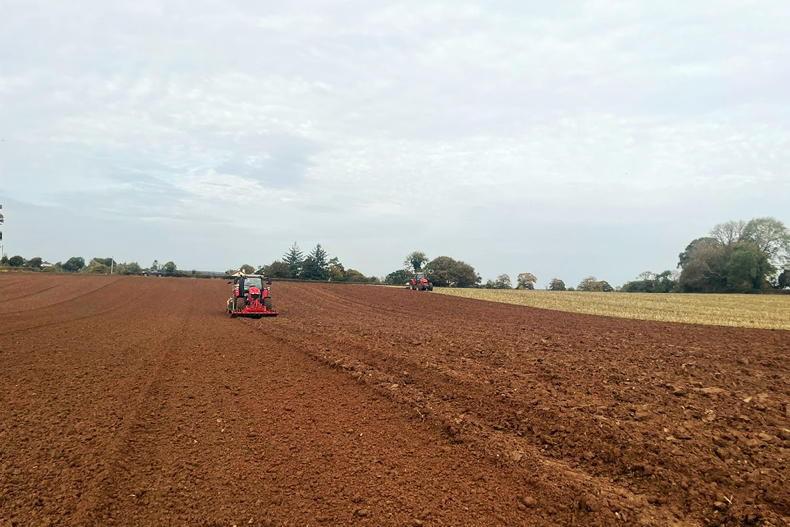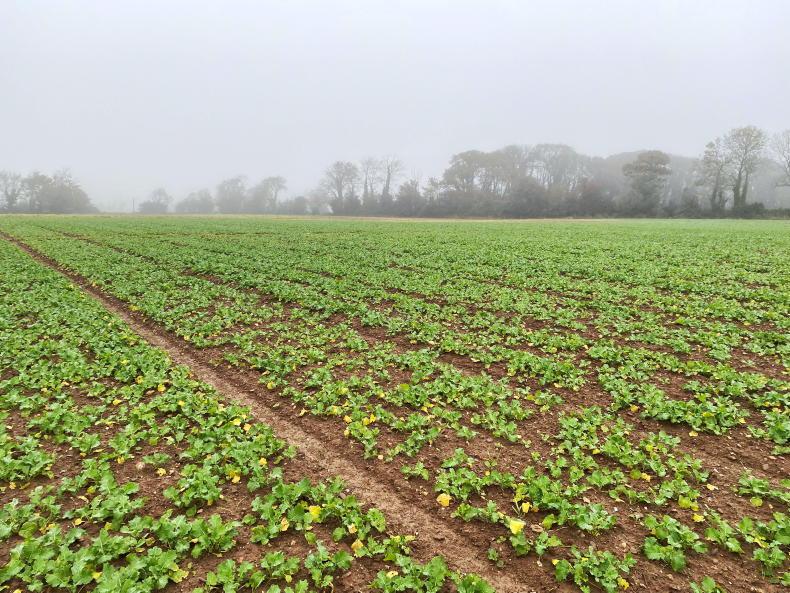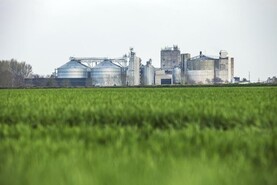Seaforde,
Co Down
Neill has made good progress in planting winter barley, with the benefits of farming light land coming to the fore in the past couple of weeks.
This has been important for Neill, as his acreage has increased for Harvest ’24, creating a much larger workload for this autumn. Therefore, he is taking every opportunity he can to get work done.
He says it is very uplifting to get some crops sown in good order after a difficult harvest.
Winter barley planting started last week, and the last of the 200ac was being completed over the weekend.
SY Armadillo and SY Canyon are the two chosen varieties, both six-row hybrid varieties, planted at 95kg/ha. Everything has been rolled after drilling and the machinery has even risen some dust!
Neill sows and rolls every field before the headlands are even ploughed, and he has a 12m wide Cambridge roller, so that every second run is on a tramline; both of these actions help to prevent soil compaction.
The maize was harvested just before storm Agnes. Neill thinks there would have been a lot of damage from this if the maize had not been harvested. The crop yielded 18t/ac, at an estimated 35% DM.
Cobs were excellent and Neill was happy with the crop, considering the dry June that it struggled through. Ground conditions were quite good and there were minimal markings made.
These fields will soon be planted with winter wheat, before the fields that were in spring beans, as the beans ground tends to stay drier for a bit longer into the autumn. KWS Extase and Graham will be planted.
The stubble turnips planted after winter barley are doing quite well, especially where chicken manure was spread beforehand. These fields will be grazed by store lambs, beginning on 1 November.
Ballygar,
Co Galway

Winter barley planting began at the weekend for Conall, with the drill staying quite close to the plough.
Land is very wet in Galway, and every time Conall has thought that it has just begun to dry out a bit, the rain has arrived again.
The original plan was to plant 150ac of winter cereals between winter barley and winter oats. Conall now says that he would be lucky to get 100ac drilled.
Conall did manage to start planting over the weekend, with the one-pass drill following the plough quite closely, leaving the headlands until last. This will be the first year that Conall has drilled using a Topcon GPS autosteer system, so he is interested to see what difference this will make to his operation.
Winter barley is being planted first. The BYDV-tolerant variety, KWS Joyau, is the variety of choice. It will be sown at 210kg/ha. This is quite a high seed rate, as Conall has found that six-row varieties do not tiller that well for him.
Soil conditions won’t be ideal and the local crow population seem quite hungry too. If land is trafficable, a pre-emergence herbicide of Tower at 2l/ha will be applied post-sowing. For the winter oats, WPB Isabel will be planted at 185kg/ha. The planned herbicide is Hurricane SC at 0.25l/ha.
Any fields that are not planted will go into spring barley or spring oats. Conall wants to minimise the spring barley area after the difficulties the crop faced this year.
Profit
Connall says this is the first year since he started that his tillage enterprise hasn’t made a profit on some of his land, with the grain price he expects to receive and the high cost of inputs really putting the squeeze on poor crops.
He adds that the recently announced tillage support scheme is nearly an insult to farmers, and while all aid is welcome, it will do little to soften the blow of this year’s returns.
Shanagarry,
Co Cork

The winter oilseed rape trial plots have been established very well on John's farm.
Land is quite wet in general in east Cork, as a consequence of the last three months of persistent rain. There was 216%, 146%, and 172% of the normal rainfall in each month respectively.
Despite this, John started ploughing for winter cereals at the weekend in the hope of planting the Goldcrop winter barley and wheat trial plots on Tuesday. The ground has ploughed up surprisingly well, due to a good soil structure.
There are also some commercial crops planned to be drilled. John will prioritise the winter wheat; most of this is after break crops, but there are also some second wheats on the farm. KWS Dawsum is the chosen variety.
Slugs
John has found a very high level of slug activity in his fields, despite running a disc through his fields in very dry conditions to try to disturb slug eggs after harvest. Therefore, John applied Axcela slug pellets a couple of days before ploughing, and he has seen dramatic results.
There have been large numbers of dead slugs present within three to four hours of application.
John likes to treat slugs at this time of year when there’s no other food source available, removing some of the risk before the seeds are placed in the ground.
He will keep a close eye on his crops after planting, and treat them where there are high numbers of slugs.
While there is no commercial winter oilseed rape on the farm, the trial plots have established very well. They received a pre-emergence herbicide of Legion, and Falcon was applied post-emergence to control grassweeds and volunteer cereals.
There was some leaf miner damage on the crop, but it was not controlled, as the crop will outgrow the damage of the pest.
John hopes that the weather becomes more agreeable next month, so that all winter crops can be planted in good conditions around the country, which would please farmers when taking stock of this difficult year over the winter months.
Seaforde,
Co Down
Neill has made good progress in planting winter barley, with the benefits of farming light land coming to the fore in the past couple of weeks.
This has been important for Neill, as his acreage has increased for Harvest ’24, creating a much larger workload for this autumn. Therefore, he is taking every opportunity he can to get work done.
He says it is very uplifting to get some crops sown in good order after a difficult harvest.
Winter barley planting started last week, and the last of the 200ac was being completed over the weekend.
SY Armadillo and SY Canyon are the two chosen varieties, both six-row hybrid varieties, planted at 95kg/ha. Everything has been rolled after drilling and the machinery has even risen some dust!
Neill sows and rolls every field before the headlands are even ploughed, and he has a 12m wide Cambridge roller, so that every second run is on a tramline; both of these actions help to prevent soil compaction.
The maize was harvested just before storm Agnes. Neill thinks there would have been a lot of damage from this if the maize had not been harvested. The crop yielded 18t/ac, at an estimated 35% DM.
Cobs were excellent and Neill was happy with the crop, considering the dry June that it struggled through. Ground conditions were quite good and there were minimal markings made.
These fields will soon be planted with winter wheat, before the fields that were in spring beans, as the beans ground tends to stay drier for a bit longer into the autumn. KWS Extase and Graham will be planted.
The stubble turnips planted after winter barley are doing quite well, especially where chicken manure was spread beforehand. These fields will be grazed by store lambs, beginning on 1 November.
Ballygar,
Co Galway

Winter barley planting began at the weekend for Conall, with the drill staying quite close to the plough.
Land is very wet in Galway, and every time Conall has thought that it has just begun to dry out a bit, the rain has arrived again.
The original plan was to plant 150ac of winter cereals between winter barley and winter oats. Conall now says that he would be lucky to get 100ac drilled.
Conall did manage to start planting over the weekend, with the one-pass drill following the plough quite closely, leaving the headlands until last. This will be the first year that Conall has drilled using a Topcon GPS autosteer system, so he is interested to see what difference this will make to his operation.
Winter barley is being planted first. The BYDV-tolerant variety, KWS Joyau, is the variety of choice. It will be sown at 210kg/ha. This is quite a high seed rate, as Conall has found that six-row varieties do not tiller that well for him.
Soil conditions won’t be ideal and the local crow population seem quite hungry too. If land is trafficable, a pre-emergence herbicide of Tower at 2l/ha will be applied post-sowing. For the winter oats, WPB Isabel will be planted at 185kg/ha. The planned herbicide is Hurricane SC at 0.25l/ha.
Any fields that are not planted will go into spring barley or spring oats. Conall wants to minimise the spring barley area after the difficulties the crop faced this year.
Profit
Connall says this is the first year since he started that his tillage enterprise hasn’t made a profit on some of his land, with the grain price he expects to receive and the high cost of inputs really putting the squeeze on poor crops.
He adds that the recently announced tillage support scheme is nearly an insult to farmers, and while all aid is welcome, it will do little to soften the blow of this year’s returns.
Shanagarry,
Co Cork

The winter oilseed rape trial plots have been established very well on John's farm.
Land is quite wet in general in east Cork, as a consequence of the last three months of persistent rain. There was 216%, 146%, and 172% of the normal rainfall in each month respectively.
Despite this, John started ploughing for winter cereals at the weekend in the hope of planting the Goldcrop winter barley and wheat trial plots on Tuesday. The ground has ploughed up surprisingly well, due to a good soil structure.
There are also some commercial crops planned to be drilled. John will prioritise the winter wheat; most of this is after break crops, but there are also some second wheats on the farm. KWS Dawsum is the chosen variety.
Slugs
John has found a very high level of slug activity in his fields, despite running a disc through his fields in very dry conditions to try to disturb slug eggs after harvest. Therefore, John applied Axcela slug pellets a couple of days before ploughing, and he has seen dramatic results.
There have been large numbers of dead slugs present within three to four hours of application.
John likes to treat slugs at this time of year when there’s no other food source available, removing some of the risk before the seeds are placed in the ground.
He will keep a close eye on his crops after planting, and treat them where there are high numbers of slugs.
While there is no commercial winter oilseed rape on the farm, the trial plots have established very well. They received a pre-emergence herbicide of Legion, and Falcon was applied post-emergence to control grassweeds and volunteer cereals.
There was some leaf miner damage on the crop, but it was not controlled, as the crop will outgrow the damage of the pest.
John hopes that the weather becomes more agreeable next month, so that all winter crops can be planted in good conditions around the country, which would please farmers when taking stock of this difficult year over the winter months.








 This is a subscriber-only article
This is a subscriber-only article










SHARING OPTIONS: